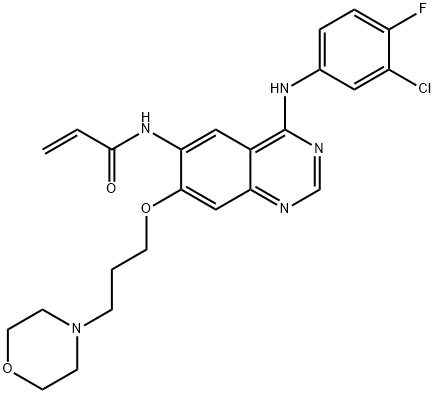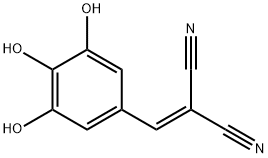METHYL 2,5-DIHYDROXYCINNAMATE
- CAS NO.:63177-57-1
- Empirical Formula: C10H10O4
- Molecular Weight: 194.18
- MDL number: MFCD00132932
- SAFETY DATA SHEET (SDS)
- Update Date: 2024-11-19 23:02:33

What is METHYL 2,5-DIHYDROXYCINNAMATE?
Chemical properties
Yellow-Brown Crystalline Powder
The Uses of METHYL 2,5-DIHYDROXYCINNAMATE
An inhibitor of the EGF receptor associated tyrosine kinase
The Uses of METHYL 2,5-DIHYDROXYCINNAMATE
A stable Erbstatin analogue that inhibits tyrosine kinase. Shown to delay the S-phase induction by epidermal growth factor in quiescent normal rat kidney cells, without affecting the total amount of DNA synthesis
What are the applications of Application
Erbstatin Analog is a stable inhibitor of EGFR tyrosine kinase
Definition
ChEBI: 2,5-dihydroxycinnamic acid methyl ester is a cinnamate ester that is the methyl ester of 2,5-dihydroxycinnamic acid. It has a role as a human urinary metabolite, a plant metabolite, a geroprotector and an EC 2.7.10.1 (receptor protein-tyrosine kinase) inhibitor. It is a cinnamate ester, a member of hydroquinones and a methyl ester.
Properties of METHYL 2,5-DIHYDROXYCINNAMATE
| Melting point: | 178-180°C |
| Density | 1.318±0.06 g/cm3 (20 ºC 760 Torr) |
| storage temp. | Keep in dark place,Sealed in dry,Room Temperature |
| solubility | 0.1 M NaOH: soluble |
| form | crystalline |
| color | yellow |
| Water Solubility | Soluble in methanol or 0.1M NaOH. Insoluble in water |
| CAS DataBase Reference | 63177-57-1(CAS DataBase Reference) |
Safety information for METHYL 2,5-DIHYDROXYCINNAMATE
| Signal word | Warning |
| Pictogram(s) |
 Skull and Crossbones Acute Toxicity GHS06  Exclamation Mark Irritant GHS07 |
| GHS Hazard Statements |
H301:Acute toxicity,oral H311:Acute toxicity,dermal H315:Skin corrosion/irritation H319:Serious eye damage/eye irritation H331:Acute toxicity,inhalation H335:Specific target organ toxicity, single exposure;Respiratory tract irritation |
| Precautionary Statement Codes |
P261:Avoid breathing dust/fume/gas/mist/vapours/spray. P264:Wash hands thoroughly after handling. P264:Wash skin thouroughly after handling. P280:Wear protective gloves/protective clothing/eye protection/face protection. P305+P351+P338:IF IN EYES: Rinse cautiously with water for several minutes. Remove contact lenses, if present and easy to do. Continuerinsing. P405:Store locked up. |
Computed Descriptors for METHYL 2,5-DIHYDROXYCINNAMATE
New Products
3-Iodophenylacetic acid 3-Pyridineacetonitrile, α-hydroxy- 2-Propanamine, 1-chloro-, hydrochloride (9CI) 3-(hexyloxy)-4-(pyridin-3-yl)-1,2,5-thiadiazole 2-Hexyn-1-ol Dibenzo-18-crown-6 Nickel(II) perchlorate hexahydrate, 98% 4-Bromophenylacetonitrile, 95% 3-Bromo-4-fluoroaniline, 97% Sodium tetraborate decahydrate, 98% Palladium(II) acetate, trimer, Pd 99% 4-Bromo-2-chlorotoluene, 97% N N Dimethylformamide Dimethyl Acetal (Dmf Dma) 2,3-Dichloro Benzoyl Cyanide [Side Chain] Bis(2-Chloroethyl) Amine Hydrochloride L-Glutamic Acid Diethyl Ester Hydrochloride 5-(Difluoromethoxy)-2-Mercaptobenzimidazole 1-Ethyl-3-(3-Dimethylaminopropyl)-Carbodiimide Hydrochloride [EDC Hcl] 1,4-Napthoquinone Bromoiodomethane Sodium Bicarbonate Methylene Dichloride (MDC) Ethyl Acetate Indole-3-Carbinol (I3C)Related products of tetrahydrofuran








You may like
-
 Methyl 2,5-dihydroxycinnamate 95% CAS 63177-57-1View Details
Methyl 2,5-dihydroxycinnamate 95% CAS 63177-57-1View Details
63177-57-1 -
 Methyl 2,5-Dihydroxycinnamate CAS 63177-57-1View Details
Methyl 2,5-Dihydroxycinnamate CAS 63177-57-1View Details
63177-57-1 -
 17604-74-9 3-Pyridineacetonitrile, α-hydroxy- 98+View Details
17604-74-9 3-Pyridineacetonitrile, α-hydroxy- 98+View Details
17604-74-9 -
 131987-69-4 98+View Details
131987-69-4 98+View Details
131987-69-4 -
 Cyclohexane, (2-propynyloxy)- 67967-07-1 98+View Details
Cyclohexane, (2-propynyloxy)- 67967-07-1 98+View Details
67967-07-1 -
 2-Propanamine, 1-chloro-, hydrochloride (9CI) 98+View Details
2-Propanamine, 1-chloro-, hydrochloride (9CI) 98+View Details
5968-21-8 -
 3-Iodophenylacetic acid 1878-69-9 98+View Details
3-Iodophenylacetic acid 1878-69-9 98+View Details
1878-69-9 -
 132945-75-6 (S)-1-Boc-3-methanesulfonyloxy-pyrrolidine 98+View Details
132945-75-6 (S)-1-Boc-3-methanesulfonyloxy-pyrrolidine 98+View Details
132945-75-6
Statement: All products displayed on this website are only used for non medical purposes such as industrial applications or scientific research, and cannot be used for clinical diagnosis or treatment of humans or animals. They are not medicinal or edible.
